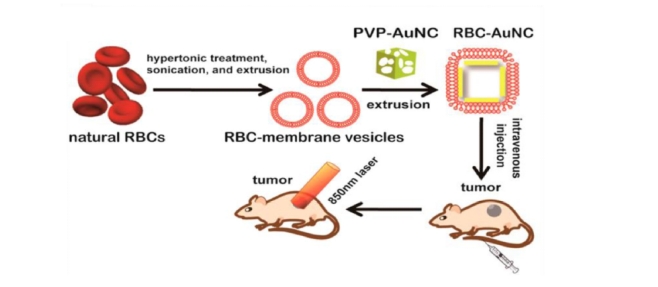CD Bioparticles offers custom surfaces of drug carriers by utilizing new coatings and modification techniques to overcome some limits by conventional modification. These drug loaded particles have longer blood circulation time and greater opportunity for specific localization with the existence of new coatings or modification like glycans, polyketals, polyvinylpyrrolidone, red cell membranes and so on.
Despite the advantages of conventional modification, poor tumor uptake and rapid clearance from the bloodstream are limitations that have hindered more clinical application of these nanostructures in conventionally modified drug delivery system. In order to overcome these limits, new coatings and modification techniques have been developed for NCs, such as glycan shielding, polyketals or AuNC/SiO2 hybrid structures known as “nanorattles”, etc.
Coatings like silica, polyvinylpyrrolidone (PVP) and red cell membranes are available to fit your special needs. The stabilizer PVP are commonly applied to impart functionality and colloidal stability to engineered nanoparticles. PVP coatings can sterically stabilizes the NPs from aggregation and is largely unaffected by salts in the physiological environment. The hybrid structure nanorattle, example AuNC/SiO2 nanorattles, can also be specially designed. The SiO2 coatings guarantee the chemical and optical stability of the AuNCs, enhances the drug loading capability, and can vastly improve the cellular uptake efficiency after further functionalization. Red blood cell (RBC) membranes have gained remarkable interest because of their intrinsically biocompatible, biodegradable and non–immunogenic properties. AuNCs with RBC shells can avoid inactivation and show a remarkably prolonged and controllable lifespan. A very recent study has shown that AuNCs could be coated with red blood cell (RBC) membranes, by which a long circulation lifetime and enhanced in-vivo blood retention was achieved compared to a polyvinylpyrrolidone (PVP) coating.
Modifications like polyketals and glycans are also options for our customers. The polyketals are synthetic polymers with ketal linkages in their backbones and have enormous potential for drug delivery because of their acid sensitivity and biocompatible degradation products. Polyketal coated particles are known as a pH-sensitive biodegradable drug delivery vehicle. These particles hydrolyze rapidly at the acidic pH of the macrophage phagosome, and this property has allowed polyketals to be effective in delivering therapeutics to macrophages. They have shown great promise for the treatment of a variety of inflammatory diseases in preclinical, animal models of disease. Glycan modifications can protect nanocarriers from immune responses. Glycans are compounds consisting of a large number of monosaccharides linked glycosidically. Particles within a protective glycan shield always have been applied as a means to evade detection of the immune system.

Figure 1. Schematic illustration of cancer treatment in mice with RBC-coated Au NCs (RBC-AuNCs) (Karimi M, et al. Nanoscale, 2017,9(4):1356-1392. Copyright 2014 the American Chemical Society)
CD Bioparticles are proficient in designing and modifying your nanoparticles with polymers, silane, cell membranes, biomacromolecules and other special required surfaces with the most recent technology. We provide customized service from the coating molecule design and screening to final nanoparticles in vivo characterization upon request.
Quotations and Ordering

References:
1. Heffernan M, Murthy N. Polyketal nanoparticles: A new pH sensitive, biodegradable drug delivery vehicle. Bioconj. Chem., 2005, 16(6), 1340-1342.
2. Hu, F., Zhang, Y., Chen, G., Li, C. and Wang, Q. Double‐Walled Au Nanocage/SiO2 Nanorattles: Integrating SERS Imaging, Drug Delivery and Photothermal Therapy. Small, 2015, 11(8), 985-993.
3. Tan S, Wu T, Zhang D, Zhang Z. Cell or cell membrane-based drug delivery systems. Theranostics, 2015, 5(8), 863.
4. Karimi M, et al. Nanocaged platforms: modification, drug delivery and nanotoxicity. Opening synthetic cages to release the tiger. Nanoscale, 2017,9(4):1356-1392.
1. Download the template.
2. Enter product information on the template (maximum number of products: 200).
3. Load the file using selector below.
1. Download the template.
2. Enter product information on the template (maximum number of products: 200).
3. Load the file using selector below.